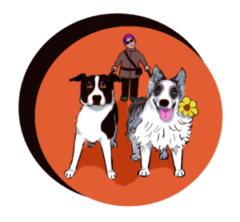
Later this month my sister, Julia Morton, and I will be heading to the Association of Professional Dog Trainers conference in Portland, Oregon. Usually Julia and I go to APDT to learn and goof off. This year we’re busy preparing a poster presentation! For the first time, the APDT Foundation invited submissions for non-academic posters and ours was accepted!
From the website:
These posters should highlight a researched topic(s) relevant to dog behavior and training including preliminary results, any completed summaries, and recommendations for next steps. The purpose of including non-academic posters this year is to include and share interesting work being done outside of College and Universities as related to dog training, behavioral studies, husbandry, management, veterinary visits, etc.
Our topic is: Dog Training Infographics – Best Practices for Conveying Complex Information. Dog trainers share infographics on social media daily. Ergo this should be of interest! If you’re planning to attend APDT please drop by!
Here’s our poster description.
Infographic is a relatively new term for a communication method that has its roots in ancient times. The purpose of this form of at-a-glance information visualization is to represent complex data, concepts, and ideas in a way that is easy to understand, and, ideally, has lasting impact. As such, infographics present exciting opportunities for educating dog training clients about behaviour, training, and care. Indeed, in recent years, with the increased availability of applications and online services to create infographics and ease of sharing through social media, we are seeing an abundance of such creations.
In this project we seek to understand the effectiveness of popular infographics shared by dog training professionals. We base our review on a set of design recommendations outlined in a study by Dunlap and Lowenthal (2016). These recommendations are categorized by three key design elements: 1) structure and form, 2) content, and 3) visual.
We are approaching this project in two phases:
- Review the education and communication literature to develop an instrument to rate a selection of infographics based on these key design elements.
- Select the most recent 5 infographics receiving more than 50 likes and 5 shares posted by dog training professionals to the Do No Harm Dog Training public Facebook group as part of their “Meme Saturday” activity. We will review each infographic for adherence to the design recommendations.
This research will help to raise awareness in the dog training community about best practices for designing infographics used to teach clients. In addition, the instrument we develop can be used to assess the effectiveness of infographics prior to sharing through social media.
In keeping with the theme, our poster will display the results of our research using an infographic.
Dunlap, J. & Lowenthal, P. (2016) Getting graphic about infographics: design lessons learned from popular infographics. Journal of Visual Literacy, 35:1, 42-59.
Krum, R. (2015) Cool infographics: Effective communication with data visualization and design. John Wiley & Sons
